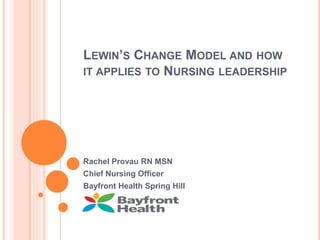
Lewin’s Change Model and how it applies to
- 1. LEWIN’S CHANGE MODEL AND HOW IT APPLIES TO NURSING LEADERSHIP Rachel Provau RN MSN Chief Nursing Officer Bayfront Health Spring Hill
- 2. OBJECTIVES 1. Understand Change Models 2. How Nursing Leadership utilizes this model 3. Example project 4. Questions?
- 3. CHANGE MODELS IN NURSING Bridges Transition Model Kotter’s 8 Step Process for Leading Change McKinsey 7-S Model Lewin Change Model None are Nurses…
- 4. WHO IS LEWIN? Kurt Lewin born in 1890 Humanitarian, Social Scientist, Physicist Theories formulated in 1940s and still in use today Areas of research – Field Theory, Group Dynamics and Action Research Referred to as the Guru of Organizational Change theory
- 5. LEWIN’S 3 STEP MODEL Unfreezing Moving or Change Refreezing
- 6. APPLICATION OF MODEL H20 How do you change it?
- 7. UNFREEZING Forced or controlled Crisis Changing the way things are done or status quo Strong reaction to change – Needed to evoke the change Finding the new equilibrium is a motivator No one likes uncertainty. Requires Strong support from management
- 8. CHANGE New Direction is shared Stakeholders identified Takes time to embrace new ideas How does it benefit the individuals and Organization Change Curve
- 9. CHANGE AGENTS – NURSING LEADERS
- 10. SECRETS TO MANAGING CHANGE Communication with a United Front. No we /they discussions or silos Dispel rumors Empower action- Utilize your naysayers as your content experts Reinforce and reward small steps in process as major victories Have a support group to help with difficult staff. It is good to hear the same thing from multiple sources
- 11. REFREEZING Evokes a New equilibrium Measure success Offer education to outliers and then accountability Don’t tweak a new process too soon Celebrate ……
- 12. APPLICATION TO NURSING LEADERSHIP Managed Care VBP Patient Centered care Social Media Multiple generations of work force Core measures HCAHPS
- 13. CHANGE CURVE IN NURSING Shock- Oh no not another form Denial – Maybe if I don’t look at emails.. Frustration- I don’t have 25 hours in my day Depression – Well I have to get this done Experiment – How can I get this done? What is the best way? Decision- I am accountable for this and will get this done. It is best for the patients/staff. Integration- Whoo… I succeeded and this feels Great!
- 14. APPLICATION OF LEWIN’S THEORY Change Announcement – In 2 weeks we will have a new product the ACME Best ever product and it will replace our Favorite product. There will be a new form to go with the ACME Best ever product as well and all staff need to make sure this form is filled out. Using the Lewin Model outline how the teams will accomplish this………
- 15. ACME BEST EVER PRODUCT UNFREEZE How do you melt the ice
- 16. ACME BEST EVER PRODUCT CHANGE How do you communicate? Immediately to prepare the staff Throughout the change how to operationalize it for your department Empower the staff to help you
- 17. ACME BEST EVER PRODUCT - REFREEZE Anchoring the change Monitor for the group that ignores the change and hold them accountable Always give a consistent message Remember If the BOOV can change so can we….
- 18. REFERENCES Mind Tools Editorial Team “Lewins’ Change Management Model” Q. Studer “Hardwiring Excellence” Mind Tools Editorial Team “Bridges’ Transition Model Porter-O’Grady, T and Malloch, K. (2010) “Quantum Leadership: Advancing Information, Transforming Health Care” Third Edition AONE Guiding Principles http://www.aone.org/resources/princip les.shtml Principles and Elements of a Healthful Practice/Work Environment http://www.aone.org/resources/leader ship%20tools/library.shtml Committee on Quality of Health Care in America, Institute of Medicine, 2000; “To Err is Human: Building a Safer Health System”, Linda T. Kohn, Janet Corrigan, and Molla S. Donaldson, Editors The Joint Commission Standards and Measurements http://www.jointcommission.org/ Becoming a High Reliability Organization http://www.ahrq.gov/qual/hroadvice/ Melynk, B. & Fineout-Overholt, E. “Evidence-Based Practice in Nursing & Healthcare: A Guide to Best Practice”